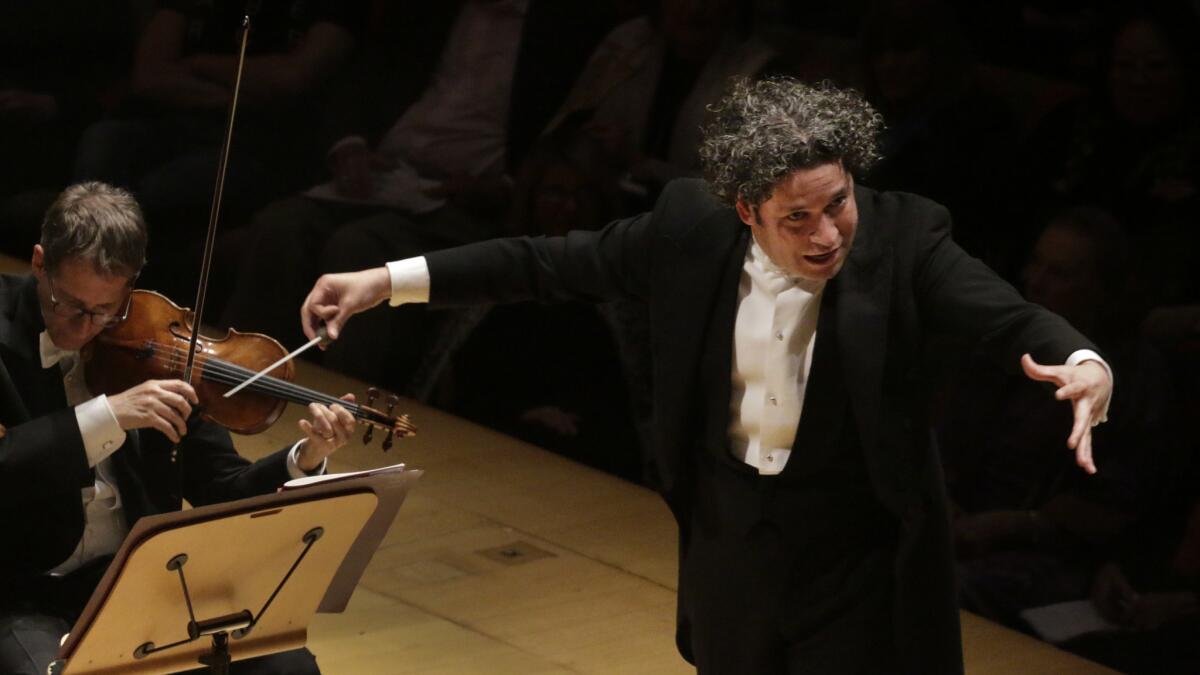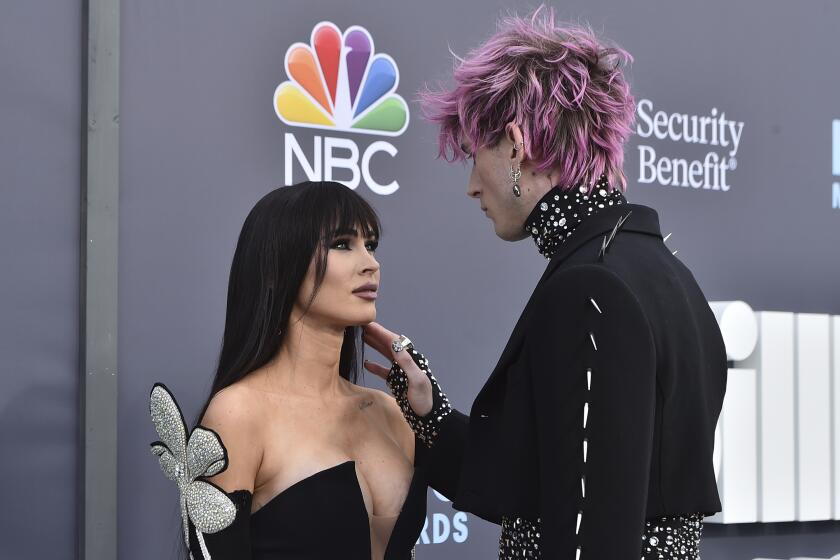Review: L.A. Philharmonic breathes fire into Saariaho world premiere

Gustavo Dudamel conducts the L.A. Philharmonic on Thursday in a program featuring Ravel and the world premiere of Kaija Saariaho’s “True Fire.”
- Share via
The Los Angeles Philharmonic has a history with Kaija Saariaho. Now among the world’s most admired composers, she was little known outside of her native Finland or adopted Paris 25 years ago when Esa-Pekka Salonen introduced her first orchestral work to L.A. and recorded it.
She has been consistently programmed by the orchestra ever since. Last fall, Salonen gave the U.S. premiere of what was her latest orchestral score, “Earth Shadow,” a work of crystalline radiance for organ and orchestra.
There is already a new latest. Thursday night at Walt Disney Concert Hall, Gustavo Dudamel conducted the world premiere of “True Fire,” Saariaho’s half-hour orchestral song cycle for baritone Gerald Finley, which the L.A. Phil commissioned.
Not only is it exceptional for an orchestra to premiere two major works by the same composer in a single season, but it is equally remarkable that Dudamel is continuing traditions begun by his predecessor. It is more common for orchestras to attempt to reinvent themselves with each new music director.
To further solidify that L.A. tradition, Dudamel surrounded Saariaho with Ravel, including the Piano Concerto for the Left Hand, with Jean-Yves Thibaudet as soloist. In 2007, the French pianist recorded that concerto with Salonen and the L.A. Phil.
Not that Thursday was, in any way, Saariaho, Ravel or even Thibaudet redux. Dudamel goes his own way. And Saariaho clearly understood that. The radiance remains, but “True Fire” is darker, closer to her recent operas. Her harmonies don’t so much glow here as present the remnant of an afterglow. Pitches bend. Strings shimmer yet feel static.
The opening, closing and middle texts come from Emerson’s “Spiritual Laws,” fine philosophies for opening our eyes, silencing our inner life and finding our “true fire” through joining our spirits with nature. But Saariaho is no romantic. Her musical language is too cool, too probing and too subtle to let Emerson get away with a hopefully bright line like “We are all photometers.” The woodwinds and percussion dampen the shine of violins.
Three poems make up the main body of the cycle, each requiring a different vocal approach from a dramatically focused and forceful Finley. Seamus Heaney’s “River” flows upstream. A poet struggles to find words, to take drink from “the deep brain,” and the baritone is asked to make every word a struggle to enunciate while a large orchestra suggests thick mud.
A Native American lullaby defiantly prepares the little ones to relish the ferocity of thunder, lightning and rain. Mahmoud Darwish’s “Farewell,” the most telling number of the cycle, reverses Heaney’s “River.” The Palestinian poet’s metaphor for death is the train that arrives at the last platform with no one there. Rather than letting words eventually come into musical being, Saariaho now takes their sound away from them.
The performance was strong. Dudamel remained constantly attuned to Saariaho’s vastly changeable instrumental colors, a cosmic sonic background for Finley, who handled each song with operatic intensity, part of a grand psychodrama of searching for meaning, for words that can obtain meaning through music but can also become emptied of meaning when sung. This is a profound, important work.
The L.A. Phil advertised the concert as an evening of glorious Ravel not probing Saariaho. Yet Dudamel managed to make the French composer reflect many of Saariaho’s sentiments.
In “Le Tombeau du Couperin,” he kept everything gracious and flowing.
But the “Left Hand” Concerto, which followed “True Fire” after intermission, begins darkly with the faintest sounds out of nowhere followed by a ravishing contra bassoon solo that Patricia Kindel made sound like it was fired from the bowels of the earth.
_____________
For the Record, May 18, 12:51 p.m. An earlier version of this review stated that a bassoon solo in Ravel’s Piano Concerto for the Left Hand was played by Whitney Crockett. The solo was played on the contra bassoon by Patricia Kindel.
______________
This is one of Ravel’s most mysterious scores and it became gripping theater once Thibaudet let his left hand come to life. He was like a jazz bandleader, egging on the orchestra, interacting with the players and offering the unbelievable impression that he was making it up on the spot.
Ending with “Bolero” was a surprisingly brilliant stroke. Dudamel revealed not normally noticed connections between this showpiece and the concerto. He had the snare drum begin the repeated rhythm at the edge of audibility. He gave individual instruments considerable freedom while maintaining a never diminishing orchestral glow.
This was true not only in the solos but even in the ensemble playing. It was fascinating to observe the difference between musicians so often asked to be cogs in an orchestral wheel. One laid-back violist strummed his instrument as if playing the blues. A violinist strummed hers while sitting forward, gripped with attention.
Conducting from memory, Dudamel let the bolero flow, a dance with a warm true fire and life of its own.
Twitter: @markswed
------------
Dudamel conducts Ravel
Where: Walt Disney Concert Hall, downtown Los Angeles
When: 8 p.m. Saturday and 2 p.m. Sunday
Cost: $26.50-$212
Info: (323) 850-2000 or https://www.laphil.org
More to Read
The biggest entertainment stories
Get our big stories about Hollywood, film, television, music, arts, culture and more right in your inbox as soon as they publish.
You may occasionally receive promotional content from the Los Angeles Times.










